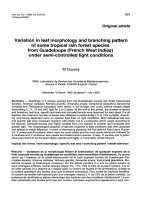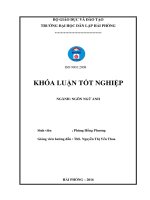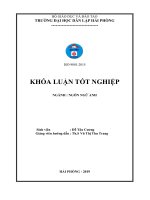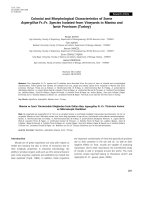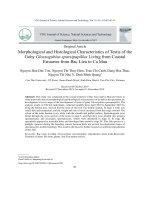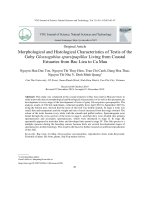Morphological and physiological characteristics of some acid tolerant fungi species (khóa luận tốt nghiệp)
Bạn đang xem bản rút gọn của tài liệu. Xem và tải ngay bản đầy đủ của tài liệu tại đây (1.75 MB, 57 trang )
VIETNAM NATIONAL UNIVERSITY OF AGRICULTURE
FACULTY OF BIOTECHNOLOGY
LE PHUONG THAO
UNDERGRADUATE THESIS
TITLE:
MORPHOLOGICAL AND PHYSIOLOGICAL
CHARACTERISTICS OF SOME ACID-TOLERANT
FUNGI SPECIES
Hanoi, March 2022
VIETNAM NATIONAL UNIVERSITY OF AGRICULTURE
FACULTY OF BIOTECHNOLOGY
UNDERGRADUATE THESIS
TITLE:
MORPHOLOGICAL AND PHYSIOLOGICAL
CHARACTERISTICS OF SOME ACID-TOLERANT
FUNGI SPECIES
Student name
: Le Phuong Thao
Class
: K62CNSHE
Faculty
: Biotechnology
Supervisors
: Nguyen Thi Thuy Hanh, PhD.
Vu Nguyen Thanh, Assoc. Prof. PhD.
Hanoi, March 2022
COMMITMENT
I hereby declare that:
This is my study, which was conducted under the guidance of the supervisors;
All data provided are true and accurate;
All published data and information have been duly cited.
Hanoi, March 2022
Student
Le Phuong Thao
i
ACKNOWLEDGEMENTS
Firstly, I would like to express my gratitude to Assoc. Prof. Dr. Vu Nguyen
Thanh – who has given me all support, guidance, all the necessary information
that made me complete the thesis. He allowed me to do the necessary research
work and use the lab equipment needed in his lab – Center for industrial
microbiology, Food Industries Research Institute. In addition, I would like to
extend our sincere esteems to all members in laboratory for their timely support.
Secondly, I owe my deep gratitude to Dr. Nguyen Thi Thuy Hanh for an
opportunity to conduct my thesis at Food Industries Research Institute and her
invaluable guidance during the past time.
It is also giving my thankfulness to friends and relatives for sharing my
difficulties and giving me various used advices during the process of learning
and studying.
Finally, I would like to thanks the leaders of Vietnam National University
of Agriculture, Department of Biotechnology and Food Industries Research
Institute for creating conditions for me to complete my thesis well.
Thank you so much!
Le Phuong Thao
ii
TABLE OF CONTENTS
COMMITMENT .................................................................................................. i
ACKNOWLEDGEMENTS ................................................................................ ii
TABLE OF CONTENTS ................................................................................... iii
LIST OF TABLES .............................................................................................. v
LIST OF FIGURES ........................................................................................... vi
ABBREVIATIONS ........................................................................................... vii
ABSTRACT ...................................................................................................... viii
I. INTRODUCTION ........................................................................................... 1
II. LITERATURE REVIEW..............................................................................3
2.1. Introduction of acid-tolerant fungi ................................................................. 3
2.1.1. Origin and characteristics of acid-tolerant fungi ........................................ 3
2.1.2. Some representative group of acid-tolerant fungi ....................................... 6
2.1.3. Introduction of the genus Penicillium ......................................................... 9
2.2. Research on acid-tolerant fungi in the world and in Vietnam ..................... 11
2.2.1. Research on acid-tolerant fungi in the world ............................................ 11
2.2.2. Research on acid-tolerant fungi in Vietnam ............................................. 13
2.3. DNA barcoding for identification for phylogenetic species recognition ..... 13
2.4. Methods to evaluate the biochemical and physiological characteristics of
fungi ........................................................................................................... 17
III. MATERIALS AND METHODS ............................................................... 19
3.1. Materials ....................................................................................................... 19
3.2. Chemicals, equipment and media ................................................................ 20
3.2.1. Chemicals .................................................................................................. 20
3.2.2. Equipment ................................................................................................. 20
3.2.3. Media ......................................................................................................... 20
3.3. Research methods ......................................................................................... 22
iii
3.3.1. Observation of colonies, cells ................................................................... 22
3.3.2. Purification and maintenance of strains .................................................... 22
3.3.3. Method for biochemical and physiological test ........................................ 22
3.3.4. DNA extraction and purification method for fungi cells .......................... 23
3.3.5. Method to classify based on DNA barcoding ........................................... 23
3.3.6. Electrophoresis method ............................................................................. 25
3.3.7. Staining the gel and reading the result ...................................................... 25
IV. RESULTS AND DISCUSSION ................................................................. 26
4.1. Observation of colonies and cells ................................................................ 26
4.2. Classification of strains based on rDNA sequence ...................................... 28
4.3. Classification of strains based on β-tubulin and calmodulin sequence ....... 31
4.4. The growth of strains on different environmental conditions ...................... 34
V. CONCLUSION AND PROPOSAL ............................................................ 37
5.1. Conclusion .................................................................................................... 37
5.2. Proposal ........................................................................................................ 37
REFERENCES .................................................................................................. 38
ANNEX ............................................................................................................... 41
iv
LIST OF TABLES
Table 2. 1. The list of the acid-tolerant fungi, the fungi originally described
as indigenous inhabitants of highly acidic habitats (pH < 3). (Hujslová et
al., 2019) ............................................................................................................... 5
Table 2. 2. Primers used for amplification and sequencing. (Visagie et al., 2005)
............................................................................................................................. 16
Table 2. 3. Thermal cycle programs used for amplification. (Visagie et al., 2005)
............................................................................................................................. 17
Table 3. 1. Origin of isolates of low pH acid-tolerant fungi strains. .................. 19
Table 3. 2. Primers used for amplification and sequencing. ............................... 24
Table 4. 1. The colony diameter at the widest part of the colony after 7 days of
cultivation. ........................................................................................................... 36
v
LIST OF FIGURES
Figure 2. 1. Extreme acidic environments. ........................................................... 4
Figure 2. 2. Morphological features of the Acidomyces acidophilus WKC-1. ..... 6
Figure 2. 3. Acidothrix acidophila. ....................................................................... 7
Figure 2. 4. Acidea extrema. ................................................................................. 8
Figure 2. 5. Microscopy of Hortaea acidophila, CBS 113389............................. 9
Figure 4. 1. Morphological characteristics of colonies and cells on PDA medium
and Malt 2Bx medium pH 1.0 of representative strains. (Bar, 10 µm) .............. 27
Figure 4. 2. Neighbour-joining phylogram depicting the relationships between
strains and neighbouring taxa based on ITS sequences. ..................................... 29
Figure 4. 3. Neighbour-joining phylogram depicting the relationships between
Amplistroma and neighbouring taxa based on D1/D2 sequences. ...................... 30
Figure 4. 4. Neighbour-joining phylogram depicting the relationships between
Penicillum and neighbouring taxa based on CaM sequences. ............................ 32
Figure 4. 5. Neighbour-joining phylogram depicting the relationships between
Penicillum and neighbouring taxa based on BenA sequences. ........................... 33
Figure 4. 6. Colonies after 7 days of cultivation on different media. ................. 35
vi
ABBREVIATIONS
DNA
Deoxyribonucleic Acid
rDNA
Recombinant Deoxyribonucleic Acid
dNTPs
Deoxyribonucleotide triphosphates
PCR
Polymerase Chain Reaction
TAE
Tris-acetate-EDTA
ITS
Internal Transcribed Spacer
BenA
β-tubulin
CaM
Calmodulin
RPB2
RNA polymerase II second largest subunit
vii
ABSTRACT
Life in natural and man-made environments with extremely low pH can be very
diverse, in which microbial studies are particularly interesting. It simply because the
importance in biotechnology and their potential solutions to environmental pollution.
This study was carried out with 19 strains that have been identified with the ability to
grow on low pH environment were isolated in Vietnam. The results of this study have
identified 8 new species including: Amplistroma sp. nov., Penicillum sp1. nov.,
Penicillum sp2. nov., Penicillum sp3. nov., Penicillum sp4. nov., Talaromyces sp1.
nov., Sarocladium sp. nov., Thyronectria sp. nov.. The above species have also been
studied in detail through DNA barcoding gene sequencing include: Internal
Transcribed Spacer (ITS), β-tubulin (BenA), Calmodulin (CaM), RNA polymerase II
second largest subunit (RPB2). Morphological and physiological information was also
clarified by culturing the strains on different media.
viii
I. INTRODUCTION
The biodiversity of microorganisms living in extreme environments has been
studied since the last century. An environment characterized by a high degree of
acidity belongs to this environment. Fungi able to tolerate acidic conditions are
frequently encountered in nature, and several species are capable of growing at very
low pH levels. There is unclear demarcation between acid-tolerant and acidophilic
fungi, but it is often assumed that acid-tolerant fungi are those that can grow at pH 1.0
and have optimum growth at pH 3.0 or below.
Studies on acid-tolerant fungi have been discovered and published since the
beginning of the last century. In 1943, a strain of Acontium velatum and a “Fungus D”
were shown to be capable of growing in a glucose medium containing 1.25M sulphuric
acid at pH 0. Unfortunately, the strain of Acontium velatum appears to have been lost
since the initial publication, but “Fungus D” is now believed to be a strain of
Acidomyces acidophilus which is commonly found in extremely acidic environments.
According to Thanh et al (2019), acidophility has been shown for only 6 fungal
species, including Acidomyces acidophilus (=Scytalidium acidophilum = Acidomyces
richmondensis = Fungus D), Acidomyces acidothermus, Acidothrix acidophila, Acidea
extrema, Acontium velatum (no living specimen available) and Hortaea acidophila
(=Neohortaea acidophila). Phylogenetically, all acid-tolerant species are Ascomycota,
and the teleomorphic state is known only for Acidomyces acidothermus (described as
Teratosphaeria acidotherma). However, studies on acid-tolerant species have not been
published much, and the confirmation of which fungal species can grow under these
conditions is still an open question.
Acid-tolerant fungi have received considerable attention, as their thermostable
enzymes can be employed in industrial processes at elevated temperatures. Increasing
the process temperature can have advantages, for example, increasing the rate of
chemical reactions, decreasing the viscosity of substrates and reducing the risk of
contamination by mesophilic microorganisms. For example, the strain Bispora sp.
1
MEY-1, well-known for the production of a range of thermophilic and acid-tolerant
lignocellulolytic enzymes.
In recent studies on acid-tolerant fungi at the Food Industry Research Institute,
many new species capable of growing in low pH conditions have been discovered.
Interestingly, most of the fungal strains identified as this new species are quite
different from previously published studies. To study this difference more clearly, we
conducted the topic: “Morphological and physiological characteristics of some acidtolerant fungi species”. This study attempts to clarify the morphology and physiology
of strains that lead to purification, identification, and practical application of some new
characteristics.
Objective:
Description of morphological and physiological characteristics of some acidtolerant fungi strains isolated in Vietnam.
Requirements:
- Observation of colony and cell morphology of acid-tolerant strains
- Classification of acid-tolerant strains
2
II. LITERATURE REVIEW
2.1. Introduction of acid-tolerant fungi
2.1.1. Origin and characteristics of acid-tolerant fungi
Extreme environments usually possess various factors incompatible with most
life forms. Thus, certain environmental conditions such as low water availability in
hyperarid deserts or high temperatures seem to be close to the limit of biological
activity (Schulze-Makuch, Airo and Schirmack, 2017). However, despite the apparent
hostility of these extreme habitats, they contain a higher level of biodiversity than
expected.
The number of different organisms known to reside and thrive in these
environmentally extreme conditions has grown rapidly in recent years. For example,
robust microbial communities at high-temperature ranges, i.e., the hot springs acidtolerant algae (Cyanidiaceae) grow at 45–56 °C (Skorupa et al., 2013) while the hyper
thermophilic archaea tolerate a temperature range above the boiling point (>100 °C)
(Kambura et al., 2016). Similarly, there are microbes living in very alkaline environments
(as high as pH 12) (Kambura et al., 2016). On the other end of the pH scale there are the
acid-tolerant archaea (i.e., Thermoplasma acidophilum) or the unicellular alga Cyanidium
caldarium thriving in very acidic habitats (pH ranges from 0–4). Furthermore, they can
survive exposure to such conditions for weeks, months, years, or even centuries (Aguilera
et al., 2007).
Eukaryotic organisms are exceedingly adaptable, and they are present in all the
extreme environments reported until now. In this regard, acid-tolerant environments
are not an exception. Although it is usually assumed that high metal concentrations in
acidic habitats limit eukaryotic growth and diversity due to their toxicity, most of these
extreme environments showed an unexpectedly high degree of eukaryotic diversity.
Extreme acidic ecosystems usually include as well different abiotic extremes than low
pH (Rothschild and Mancinelli, 2001); (Tiquia-Arashiro and Rodrigues, 2016). Thus,
eukaryotes thriving at these habitats are often also exposed to low nutrient levels
(Brake and Hasiotis, 2010), high concentrations of toxic metals (Aguilera et al., 2007),
3
and/or extreme temperature (González-Toril et al., 2015). Additionally, several studies
have revealed representatives from multiple evolutionary eukaryotic lineages,
suggesting that the ability to adapt to pH extremes may be widespread (Amaral Zettler
et al., 2002).
Figure 2. 1. Extreme acidic environments.
(a) Seltun acidic geothermal area, SW Iceland, (b) elemental sulfur forming from gases venting the
Soufriere Hills volcano on Montserrat, West Indies, (c) terraces formed by iron precipitates in Río
Tinto, SW Spain, (d) Río Tinto, SW Spain, at Salinas site (Aguilera and González-Toril, 2019).
Acid-tolerant fungi have been reported from various acidic environments.
Hitherto, five fungal species isolated from acidic environments are known to be able
to grow in extremely acidic conditions. Acontium velatum Morgan was isolated from
a solution containing 4% copper sulfate (pH 0.2–0.7) (Starkey and Waksman, 1943).
Trichosporon cerebriae (an invalid name) was reported to grow in 2-N sulfuric acid
solution containing glucose and peptone (Sletten and Skinner, 1948). Capnodialean
anamorphic fungi were also isolated from acidic environments. Acidomyces
acidophilus was reported as an acid-tolerant species and has been isolated from the
soil (pH 1.4–3.5) adjacent to a sulphur pilefield from a natural gas purification plant
as Scytalidium acidophilum (Sigler and Carmichael, 1974) and acid mine drainage
4
(pH 0.8–1.38) as „Acidomyces richmondensis‟ (nom. inval.) (Baker et al., 2004).
Hortaea acidophila Hoălker et al. was also isolated from brown coal (pH 0.6)
containing humic and fulvic acids (Hölker et al., 2004). These latter two species
were reported to be able to grow even at pH 1 (Sigler and Carmichael 1974; Baker et
al. 2004; Hölker et al., 2004; Selbmann et al., 2008). Interestingly, these acidtolerant fungi mentioned above are all anamorphic fungi, and no teleomorphic
species have been reported from such highly acidic environments.
Table 2. 1. The list of the acid-tolerant fungi, the fungi originally described as
indigenous inhabitants of highly acidic habitats (pH < 3). (Hujslová et al., 2019)
Species
Acidea extrema
Acidiella bohemica
Isolated from
Highly acidic soil (Czech Republic)
Biofilm from the highly acidic river (Spain)
Highly acidic soil (Czech Republic) Biofilm from the highly acidic river
(Spain) Abandoned mine (Japan)
Highly acidic oil shale by-products (Brazil)
Highly acidic water from uranium mine (Australia)
Highly acidic river water and sediment (Spain)d
Acid-tolerant algae, acid drainage (Germany)
Soil near sulfur pile (Canada) Sulfuric acid (Denmark) Volcanic soil
Acidomyces acidophilus (Iceland)
Acidic industrial water (The Netherlands) Highly acidic soil (Czech
Republic)
Highly acidic hot springs (Japan)
Highly acidic water from uranium mine (Australia) Acidic waste water of
Acidomyces acidothermus
uranium mine (China) Highly acidic soil (Czech Republic, Iceland) Acid
mine drainage biofilm (USA) Acid transfer pipeline (India)
Highly acidic soil (Czech Republic)
Acidothrix acidophila Enrichment culture
of
archaeal
Richmond mine
Acid-tolerant Nanoorganisms from biofilms of mine (Germany)
Highly acidic water from uranium mine (Australia)
Coniochaeta fodinicola Acidic waste water from uranium mine (China) Highly acidic soil (Czech
Republic)
Acidiella uranophilac
Neohortaea acidophila
Soosiella minima
Extract of brown coal with humic and fulvic acids, pH 0.6 (Germany)
Highly acidic soil (Czech Republic)
5
2.1.2. Some representative group of acid-tolerant fungi
Acidomyces acidophilus
Acidomyces acidophilus is a fungus first described by Sigler & J.W. Carmich
and again described by Selbmann, de Hoog & De Leo in 2008. Acidomyces
acidophilus is part of the genus Acidomyces and the family Teratosphaeriaceae, it is
also known as Scytalidium acidophilum, "Fungus D" or Trichosporon cerebriforme.
It contains melanin in cell walls that protect fungi from adverse environmental
conditions such as pH, temperature and extreme toxins. Anamorphic fungi,
hyphomycetes. Colonies growing slowly, faster in acidic medium, compact, dark.
Mycelium composed of septate, scarcely branched, brown and thick-walled hyphae,
eventually converting into a meristematic mycelium. Conidia produced by arthric
disarticulation of hyphae Figure 2.2 (Chan et al., 2019).
Figure 2. 2. Morphological features of the Acidomyces acidophilus WKC-1.
(a) colony of the isolated fungal strain in CDA medium, (b) Filamentous hyphae of the strain
with intercalary and unbranched hyphae with melanised and thick-walled cells and (c) Hyphae
terminal swelling cell using scanning electron microscope (SEM) at a magnification of 1000×
(b) and 2200× (c), scale bar in (b) and (c) 2 μm (Chan et al., 2019).
Acidothrix acidophila
Acidothrix acidophila is an acidic soil fungus. It belongs to the family
Amplistromataceae (Sordariomycetes, Ascomycota). The family Amplistromataceae
has been established for two genera, Amplistroma and Wallrothiella, of exclusively
6
wood- inhabiting fungi with similar morphological characteristics and acrodontiumlike asexual morphs (Huhndorf et al., 2009). Colonies on MEA (pH 5.5) at 24°C, 21
days reaching a diameter of 76–77 mm; spreading, with abundant aerial mycelium
forming floccules and funicules, sporulation abundant, white to slightly salmon
(5YR8/2), reverse honey to ochre (5YR5/10). Colonies on acidic medium (MEA pH
2) achieving diameters of 19–33 mm in 21 days at 24°C; compact, centrally forming
funicules, with ruffled margin, powdery, coloured white, reverse cream to beige. On
PCA at 24°C in 21 days colonies compact, centrally heaped with flat margin, without
aerial mycelium, yeast-like; reaching 15–20 mm in diam. Conidiophores
semimacronematous consisting of a single phialide only, or macronematous
consisting of stipe bearing two to six phialides, sometimes in verticilate arrangement
(prostrate). Stipe 10–20 × 2.5–3.0 μm (Hujslová et al., 2014).
Figure 2. 3. Acidothrix acidophila.
a,b - Colony on MEA pH5.5 at 24°C, 21days; c - Colony on MEA pH2 at 24°C, 21days; dConidia globose,elipsoidalor lacrimose with hilum; e-h - Conidiophores and conidia; i Conidia proliferating by hyphae and bearing other conidia. Scale bars=10 μm
Acidea extrema
Acidea extrema is a fungus first described by Hujslová & M. Kolarík, isolated
from acidic soil (pH 2), belonging to the genus Acidea. Colonies on MEA (pH 5.5)
7
at 24 °C, 21 days reaching a diameter of 17–36 mm, on acidic medium (MEA pH 2)
achieving diameters of 17.5–23 mm in 21 days at 24 °C. On both media colonies
compact, in some isolates with ruffled margin, centrally heaped to cerebriform,
wrinkled, funiculose or yeast-like, white to beige (10YR7/4), reverse honey to ochre
(7.5YR5/10). On PCA at 24 °C in 21 days colonies compact, centrally heaped with
flat margin, without aerial mycelium, yeast-like; 25 mm in diam. Mycelium sterile,
2.2– 0.5.5 μm wide, sparsely branched, fully filled with single line of granules, often
fragmenting. Sexual morph unknown (Hujslová et al., 2014).
Figure 2. 4. Acidea extrema.
a - Colony on MEA pH2 at24°C, 21days; b - Colony on MEA pH5.5 at 24°C, 21days;
c,d,e - Sterile mycelium fully filled with granules; Soosiella minima. f - Colony on MEA
pH 5.5 at 24°C, 21 days; g, h - Sterile mycelium irregularly granular. Scale bars=10μm
Hortaea acidophila
H. werneckii was accommodated in Hortaea. It is a hitherto black yeast was
isolated from an extract of brown coal containing humic and fulvic acids at pH 0.6.
Colonies on PDA at 25 °C attaining about 4 mm in 10 days, glistening, smooth, slimy,
jet black. Budding cells initially subhyaline, smooth, thin-walled, ellipsoidal, about
2.5-3.0 x 1.5-2.0 µm, later swelling, becoming darker and developing a central
8
septum, then broadly ellipsoidal, up to about 6 x 4 µm. Hyphae initially pale
olivaceous, thin-walled, often starting with a series of ellipsoidal cells (toruose
hyphae), later becoming darker with thicker walls, pigmentation finally becoming
somewhat irregular; hyphae about 2.0-2.5 µm wide, cells about 12-20 µm long,
occasionally subdivided in a later stage. Local clumps of blackish-brown extracellular
material are produced. Single annellated zones inserted laterally on each intercalary
cell, about 1.0-1.5 µm wide, very short, annellations usually invisible with the light
microscope. Conidia soon developing into yeast cells (Hölker et al., 2004).
Figure 2. 5. Microscopy of Hortaea acidophila, CBS 113389.
Hyphae with annellated zones, and conidia (Hölker et al., 2004). Bar represents 10 µm.
2.1.3. Introduction of the genus Penicillium
Although almost studies on acid-tolerant fungi have not mentioned the
Penicillium group, Penicillium is still considered as a group of fungi capable of
growing under these conditions. It may be due to the prevalence of this genus
and the difficulties in determining precisely whether they are acid tolerant. Many
published studies have confirmed that some Penicillium spp. can grow on low
pH. One example is Penicillium sp. CGMCC 1669, which can grow at pH 3.5 and
generate endo-polygalacturonase applied in Clarification of fruit, vegetable juices
and wines. (Yuan et al., 2011). In studies at the Food Industries Research
Institute, many strains of the genus penicillium have been isolated on low pH
medium, even pH <1.
9
Penicillium is well known and one of the most common fungi occurring in a
diverse range of habitats, from soil to vegetation to air, indoor environments and
various food products. It has a worldwide distribution and a large economic impact
on human life.). Some species also have positive impacts, with the food industry
exploiting some species for the production of specialty cheeses, such as Camembert
or Roquefort and fermented sausages. Their degradative ability has resulted in
species being screened for the production of novel enzymes. Its biggest impact and
claim to fame is the production of penicillin, which revolutionised medical
approaches to treating bacterial diseases. Many other extrolites have since been
discovered that are used for a wide range of applications (Frisvad and Samson,
2004). Pitt (1979) considered it axiomatic that Penicillium or one of its products has
affected every modern human.
It is now more than 200 years since Link (1809) introduced the generic name
Penicillium, meaning „brush‟, and described the three species P. candidum, P.
glaucum and the generic type P. expansum. Since then, more than 1000 names were
introduced in the genus. Many of these names are not recognizable today because
descriptions were incomplete by modern criteria.
In anticipation of this change, Houbraken & Samson (2011) redefined the
genera in the family Trichocomaceae based on a four gene phylogeny. They
segregated the Trichocomaceae into three families, namely the Aspergillaceae
(Aspergillus, Hamigera, Leiothecium, Monascus, Penicilliopsis, Penicillium,
Phialomyces,
Sclerocleista,
Warcupiella,
Xeromyces),
Thermoascaceae
(Byssochlamys/Paecilomyces, Thermoascus) and the Trichocomaceae (Rasamsonia,
Sagenomella, Talaromyces, Thermomyces, Trichocoma). Penicillium subgenus
Biverticillium and Talaromyces were shown to form a monophyletic clade distinct
from the other subgenera of Penicillium, with these names recombined as necessary
into Talaromyces. The remaining Penicillium species formed a monophyletic clade
together with species classified in Eupenicillium, Eladia, Hemicarpenteles,
Torulomyces, Thysanophora and Chromocleista. These generic names were
synonymised with Penicillium, while their species were given Penicillium names
10
(Houbraken and Samson, 2011). The remaining three Aspergillus species, A.
paradoxus (≡ Hemicarpenteles paradoxus), A. malodoratus and A. crystallinus,
phylogenetically belonging in Penicillium, are transferred to Penicillium below in
the Taxonomy section. To accommodate the morphological variation, the generic
diagnosis of Penicillium was amended in Houbraken & Samson (2011). Most
importantly, in comparison with the prevailing generic concept, it now excludes the
acerose phialides and usually symmetrically branched conidiophores of species now
included in Talaromyces, and was expanded to include the conidiophores with
solitary phialides of species in section Torulomyces, and the darkly pigmented stipes
that formerly characterised the genus Thysanophora, which show secondary growth
by means of the proliferation of an apical penicillus. For infrageneric classification,
the genus was divided into two subgenera, Aspergilloides and Penicillium, and 25
sections.
2.2. Research on acid-tolerant fungi in the world and in Vietnam
2.2.1. Research on acid-tolerant fungi in the world
Interest in discovering extreme environments and the organisms that inhabit
them has grown over the past years due to both basic research, and applied aspects,
i.e., extremophiles as the sources of enzymes and other cell products. The
biotechnological potential of extremophiles and their cellular products is now a
major impetus driving research. The fields of biotechnology that could benefit from
mining the extremophiles are numerous and include the search for new bioactive
compounds for industrial, agricultural, environmental, and pharmaceutical uses
(Tiquia-Arashiro and Rodrigues, 2016); (Krüger et al., 2018). An example, the
remarkable tolerance of A. acidophilus to adverse conditions and its significant
variability and ability to mediate in extreme acidity ecosystems where most forms of
life may open up research opportunities and exploration for planetary and
astrobiological studies in the search of life on acidic and hot planets such as our
sister planet, Venus (Chan et al., 2019).
Although A. acidophilus has proven to be effective in removing metalloids
such as arsenic in soil in laboratory settings, in order to apply it to remediate
11
contaminated soil effectively it needs to be scaled up accordingly. Recent advances
in molecular biology and biotechnology techniques can be applied to genetic modify
A. acidophilus to improve its remediation capabilities. The genes involved in the
detoxification of heavy metals in A.acidophilus can be cloned and expressed in a
fast-growing host. Various genetic engineering approaches have been developed to
optimize mycoremediation by engineer- improved fungi and enzymes. A. acidophilus
contains several genes that encode glutathione S-transferase and through genetic
splicing or gene regulations, these important genes that reduce the toxicity of arsenic
from arsenate to arsenite can be overexpressed or used to construct new metabolic
pathways in other fungi, allowing the novel enzymes/genes that are produced by A.
acidophilus to be used to remediate not only metals but also other pollutants (Chan
et al., 2019).
Knowledge of the phylogenetic and physiological diversities of acid-tolerant
microorganisms has expanded greatly in the past 25 years. Data from biomolecular
studies of extremely acidic sites, however, suggest that a large number of
extremophilic fungi in general and particularly acid-tolerant ones still await isolation
and characterization. There is a great deal of interest in acidophiles, not only from
the standpoint of understanding how these microorganisms can thrive in conditions
that are hostile to most life forms but also due to their importance in environmental
pollution and in biotechnology. To date little is known regarding the role of acidtolerant fungi in shaping the varied ecosystems that occur in acidic environments
and less about whether these microorganisms can support microenvironmental
conditions that increase the survival of other members of the microbial community, or
the interaction between different organisms enhances colonization of others. Acidtolerant fungi have to play an even more important role in the development of
microbial communities in extreme environments by providing a suitable
architectural structure, mechanical stability, and protection against external
conditions and be able to selectively accumulate metals from the surrounding water
(Aguilera and González-Toril, 2019).
12
2.2.2. Research on acid-tolerant fungi in Vietnam
In recent years, scientists have paid special attention to the strains of fungi
that can survive and thrive in harsh environmental conditions. However, regarding
the fungus that is resistant to strong acids, there is still no specific study in Vietnam.
Special attention is paid to the biodiversity and properties related to the enzymegenerating ability of strains. Aside from the recently emerging heat-resistant fungi
enzyme as a promising alternative in biotechnology applications, the acid-resistant
fungi enzyme is still a relatively new problem. Scientists around the world have been
going deeper into this group of potential fungi, but currently there is no scientific
work in in-depth research in this field. In Vietnam, although agriculture is the
foundation for development, the problem of research and application of science in
production is still very limited. With the advantage of being a tropical country, it can
be said that it is not too difficult for us to find the fungus strains with precious
properties and do in-depth studies, with long-term possible applications, industry,
agriculture and life (Thanh et al., 2019).
2.3. DNA barcoding for identification for phylogenetic species recognition
DNA barcoding was launched to make species identification of any
eukaryotic organism possible for anybody, by using a standardized short DNA
sequence and a curated reference database linked to authoritatively identified
vouchers. Only recently however, was the internal transcribed spacer rDNA area
(ITS) accepted as the official barcode for fungi (Schoch et al., 2012). ITS is the most
widely sequenced marker for fungi, and universal primers are available (Schoch et
al., 2012). In Penicillium, it works well for placing strains into a species complex or
one of the 25 sections, and sometimes provides a species identification (Visagie et
al., 2014). Unfortunately, for Penicillium and many other genera of ascomycetes, the
ITS is not variable enough for distinguishing all closely related species. The opensource sequence repository GenBank contains a large proportion of incorrectly
identified sequences, making identifications of Penicillium using BLAST very tricky
for inexperienced workers. This particular problem is addressed in a number of
publications. For Penicillium, the International Commission of Penicillium and
13
Aspergillus (ICPA), in conjunction with the publication of an updated accepted
species list presented below, decided to include GenBank accession numbers to
reference barcode sequences for each species when available.
Because of the limitations associated with ITS as a species marker in
Penicillium, a secondary barcode or identification marker is often needed for
identifying isolates to species level. The requirements for a secondary identification
marker are clear. It should be easy to amplify, distinguish among closely related
species and most importantly, the reference data set should be complete, meaning
that there should be representative sequences for all species. It would be an added
bonus if this marker is useful for phylogenetic studies, as it will by default become
the gene most widely sequenced in future. Based on these criteria, the use of βtubulin (BenA) is the best option for a secondary identification marker for
Penicillium. Although not influencing BLAST identifications, alignments across a
diverse genus like Penicillium is difficult and often contains a large proportion
ambiguously aligned sites, which can make phylogenies difficult. Also, there is
evidence for the amplification of BenA paralogous genes in Aspergillus and
Talaromyces (Peterson and Jurjević, 2013) and it can thus be assumed that the same
might be happening in some Penicillium species. Other possible secondary marker
options include calmodulin (CaM) or the RNA polymerase II second largest subunit
(RPB2) genes. Both these genes have similar role as BenA. RPB2 has the added
advantage of lacking introns in the amplicon, allowing robust and easy alignments
when used for phylogenies, but it is sometimes difficult to amplify and the database
is incomplete. Thus, for routine identifications BenA is currently recommended,
while for the description of new species, the use of ITS, BenA, CaM and RPB2 are
suggested among the markers for multilocus sequence typing and GCPSR.
BenA can successfully be used for accurately identifying Penicillium species.
However, as is the case for genes other than BenA, care should be taken in specific
groups or situations. Infraspecies variation in BenA occurs in some Penicillium
species as is observed in phylogenies published for Penicillium. This variation must
14
be considered for identification purposes and especially when considering whether a
strain might represent a new species. This means that in addition to the reference
sequences of ex-type cultures sanctioned by ICPA, additional reference sequences
are necessary to document sequence variation that differ from the ex-type. ICPA is
currently working on populating such a validated database to capture infraspecies
variation, but for the time being critical phylogenetic revisions of different sections
should be referred to for reliable data. Alternatively, combining ITS, BenA, CaM
and RPB2 from a suspected new species with sequences of the same markers from
related species will aid in deciding whether a species is new or not. This is in fact
common practise in most studies describing and characterising Penicillium species.
BenA works well for species identifications in Penicillium. P. chrysogenum
and P. allii-sativi is one example where identification based on BenA should be
made with care (Houbraken et al., 2012). This is a consequence of the variation
observed among strains of P. chrysogenum, which results in P. allii-sativi forming a
clade within the P. chrysogenum clade in BenA species trees. Even though CaM
distinguishes P. chrysogenum from P. allii-sativi, it does not distinguish P.
chrysogenum and P. rubens. As a result, molecular identifications should be made
with great care in section Chrysogena, with the revision. Penicillium kongii was
recently introduced as a close relative of P. brevicompactum (Wang and Wang,
2013). Even though this species formed a coherent clade distinct from the P.
brevicompactum ex-type strain, on examining additional strains previously identified
as P. brevicompactum, the P. kongii clade is resolved within the P. brevicompactum
clade. This clade thus requires more work to resolve the species from the complex.
A similar situation is observed for P. desertorum and the newly described P.
glycyrrhizacola (Chen et al., 2013), where more strains and additional genes
included in the phylogeny will help to resolve species. Another species that cannot
be identified using molecular data is P. camemberti, P. caseifulvum and P.
commune, which shares identical BenA and other gene sequences (Giraud et al.,
15


